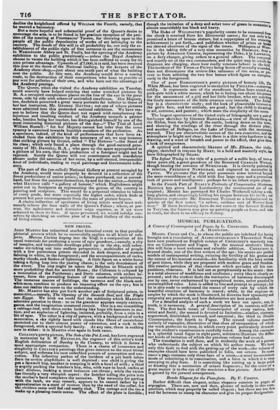MUSICAL PUBLICATIONS.
A Course of Counterpoint and Fugue, by L. CirERUIIINI. Translatedby J. A. HAMILTON.
Messrs. COCKS and Co., to whom the public are indebted for having
brought out a translation of ALBRICHTSSERGER'S TheOl'etiCRI have now produced an English version of CHERUBINI'S masterly trek tise on Counterpoint and Fugue. To the musical student's library this will form a most welcome and valuable addition. CHERUBINI beyond doubt, one of the first writers of the age: his scores are perfect models of contrapuntal writing, evincing the fertility of his genius and the extent of his musical research—his familiarity with the best writers of past times, while they are pregnant with modern grace and freedom. His treatise partakes of that character which pervades all his com- positions, clearness. It is laid out as perspicuously as his score : there is a total absence of muddiness and confusion ; every idea is clearly ex- pressed; and the student finds the intricacies of harmony disentangled one by one, never embarrassed by unexplained terms, never puzzled by unexemplified rules. Line is added to line and precept to precept ; but he is also made to understand the reason of every rule by which the beautiful structure of harmony is reared ; while, in the copious ex- amples by which the work is illustrated, lie discerns how symmetry and congruity are preserved, and how deformities are best avoided.
For a detailed analysis of such a work we have not space; nor, in truth, is it necessary. A general description of its contents will suf- fice. The first book treats of Counterpoint of every variety, both strict and florid ; the second is devoted to Imitation—similar, contrary, augmented, diminished, reversed, and canonical ; the third to Double Counterpoint; the fourth to Fugue. The second volume consists entirely of examples, illustrative of that class of composition of which the work professes to treat, in which every point particularly demand- ing the student's examination is carefully noted. Among the examples is a splendid tonal fugue in eight parts, written to illustrate the differ- ent kinds of imitation of which the previous volume had treated. The translation is well done, and is evidently the work of a person who understands the subject on which his author treats. We have only this fault to find with the getting-up of the work—the volume of examples should have been published in folio, not octavo. In some eases a page contains only three bars of a score,—a most inconvenient mode ot submitting it to examination, and a form in which it is very annoying to play from. It is something like cutting up a large print or drawing into a succession of octavo fragments ; for the score of a great master is to the eye of the musician a fine picture. And nothing is gained by the present arrangement.


























 Previous page
Previous page